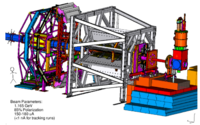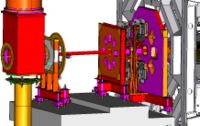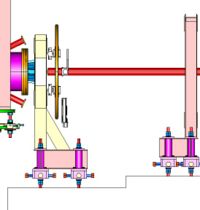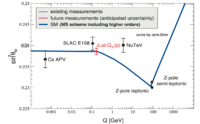Difference between revisions of "DNP 2009 R1 Talk"
| Line 27: | Line 27: | ||
[[Image:QweakGEMlocation_11-29-07.jpg | 200 px]] side view [[Image:QweakGEMlocation_11-29-07_SideView.jpg | 200 px]] | [[Image:QweakGEMlocation_11-29-07.jpg | 200 px]] side view [[Image:QweakGEMlocation_11-29-07_SideView.jpg | 200 px]] | ||
| − | [[File:QweakRunnningSinThetaW_7-09. | + | [[File:QweakRunnningSinThetaW_7-09.jpg | 200 px]] |
=Slide 3= | =Slide 3= | ||
Revision as of 15:10, 1 October 2009
Abstract
A tracking subsystem for the Qweak experiment at Jefferson Lab has been constructed using gas electron multipliers (GEMs) to enable the detection of elastically scattered electrons at high rates. Unlike other similar tracking devices, the GEM based tracking system uses a polar coordinate system and custom designed digitization cards for readout. The coordinate system was chosen to simplify a measurement of the elastically scattered electron's squared momentum transfer. The readout electronics, designed at CERN, may be used by either silicon or GEM based detectors. The compact readout system has a high radiation tolerance and contains 128 readout channels per card. Each channel is sampled up to 40 MHz and is buffered to facilitate readout latencies up to 128 clock cycles. A description of the tracking system and the performance of the readout system will be presented.
Slide 1
The GEM Tracking Subsystem for Qweak
- Outline
- Physics
- Tracking requirements
- Apparatus
Slide 2
The Qweak experiment
goal: measure at with a relative systematic + statistical error of 0.3%
Installation begins in JLab's Hall C next month
The 2200 hour measurement of the parity violating asymmetry in elastic ep scattering at Q2=0.03 (GeV/c)2 employing 180 A of 85% polarized beam on a 35 cm liquid Hydrogen target will begin in 2010



